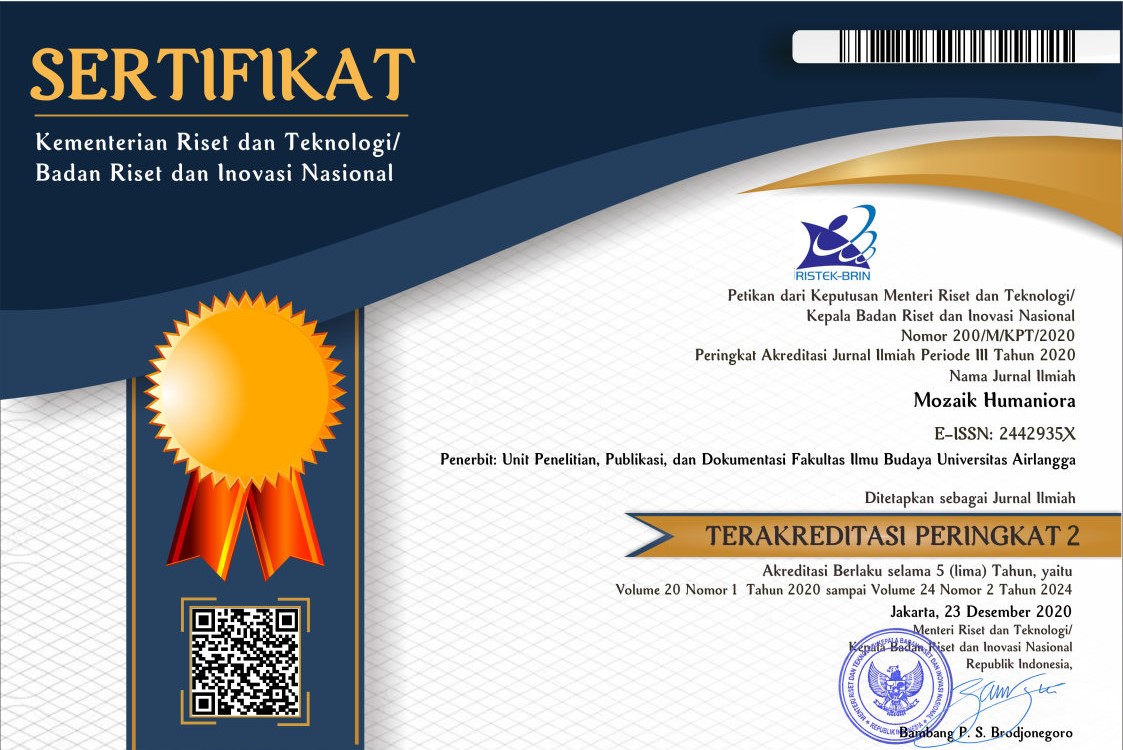Pemarkahan Diatesis Bahasa Indonesia: Kajian Tipologi Linguistik
Downloads
Sistem diatesis suatu bahasa terkait erat dengan sistem pemarkahannya, baik pemarkahan secara morfologis maupun secara sintaktis. Secara linguistik tipologi, bahasa akusatif memiliki diatesis aktif dan pasif, sedangkan bahasa ergatif memiliki diatesis ergatif dan antipasif. Bahasa Indonesia digolongkan sebagai bahasa yang memiliki diatesis aktif dan pasif, sehingga bahasa Indonesia dapat dimasukkan ke dalam kelompok bahasa akusatif. Berdasarkan kajian diatesis yang dilihat dari perspektif linguistik tipologi, diatesis aktif dan pasif bahasa Indonesia menunjukkan perbedaan yang signifikan jika dibandingkan dengan diatesis aktif pasif dalam bahasa yg bertipe akusatif. Bahasa Indonesia memiliki dua tipe pasif: ‘pasif di-' dan ‘pasif pronomina'. Berdasarkan sistem kebermarkahan, konstruksi pasif di- yang dimarkahi secara morfologis memiliki bentuk aktif yang juga dimarkahi secara morfologis. Dengan kata lain, konstruksi pasif di- memiliki diatesis aktif dan pasif yang sama-sama memiliki pemarkahan secara morfologis. Dalam konstruksi pasif di-, verba yang menunjukkan diatesis pasif dimarkahi oleh prefiks di-, sedangkan verba yang menunjukkan diatesis aktif dimarkahi oleh prefiks meng-. Secara sintaktis, subjek kalimat pasif berfungsi sebagai ajung (adjunct) dalam bentuk frasa preposisional dan bisa dilesapkan. Pada konstruksi pasif pronomina, verba yang menunjukkan diatesis pasif muncul dalam bentuk verba dasar, sedangkan verba yang menunjukkan diatesis aktif dimarkahi oleh prefix meng-. Agen dalam kalimat pasif pronomina tidak dapat dilesapkan. Hal ini menunjukkan bahwa dalam pasif pronomina, diatesis aktif lebih bermarkah daripada diatesis pasifnya. Dengan demikian dapat disimpulkan bahwa berdasarkan pendekatan tipologi linguistik, diatesis aktif dan pasif dalam bahasa Indonesia tidak memenuhi persyaratan diatesis secara tipologi.
Kata Kunci: diatesis, aktif, pasif, akusatif, ergatif
Alwi, H. dkk. 1988. Tata Bahasa Baku Bahasa Indonesia. Jakarta: Balai Pustaka
Blake, B. J. 1988. Tagalog and the Manila-MT Isa axis. La Trobe Working Papers in Linguistics 1: 77-90.
Comrie, B. l978. Ergativity. Dalam Lehman, W.D. (ed). Syntactic Typology:
studies in the phenomenology of language, 329-354. Austin: The University of Texas.
Comrie, B. 1988. Passive and voice. Dalam Shibatani, M. (ed). Passive and Voice, 9-23. Amsterdam: John Benjamins.
Dixon, R. M. W. 1972. The Dyirbal Language of North Quensland. Cambridge: Cambridge University Press.
Dixon, R.M.W. 1994. Ergativity. Cambridge: Cambridge University Press.
Dixon, R.M.W. 2010. Basic Linguistic Theory Volume 2. Oxford: Oxford University Press
Huddleston, R. and Pullum, G. 2008. The Cambridge Grammar of the English Language. Cambridge: Cambridge Universit
Kaswanti Purwo, B. (ed.). 1989. Serpih-Serpih Telaah Pasif Bahasa Indonesia. Jogjakarta: Kanisius.
Lyons, J. 1968. Introduction to Theoretical Linguistics. London: Cambridge University Press.
Mallinson, G. and Blake, B. J. 1981. Language Typology: cross-linguistic studies on syntax. Amsterdam: North-Holland.
Sneddon, J. 1996. Indonesian Reference Grammar. London: Routledge
Tsujimura, N, 1996. An Introduction to Japanese Linguistics. Oxford: Basil Blackwell

Mozaik Humaniora is licensed under a Creative Commons Attribution-ShareAlike 4.0 International License. Both authors and Mozaik Humaniora agree with the following attribution of journal:
1. Copyright of this journal is possession of Author, by the knowledge of the Editorial Board and Journal Manager, while the moral right of the publication belongs to the author.
2. The journal allows the author(s) to retain publishing rights without restrictions
3. The legal formal aspect of journal publication accessibility refers to Creative Commons Attribution Share-Alike (CC BY-SA).
4. The Creative Commons Attribution Share-Alike (CC BY-SA) license allows re-distribution and re-use of a licensed work on the conditions that the creator is appropriately credited and that any derivative work is made available under "the same, similar or a compatible license”. Other than the conditions mentioned above, the editorial board is not responsible for copyright violation.


















